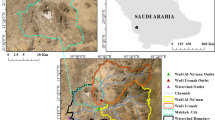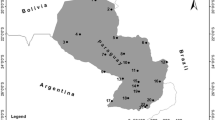Abstract
This paper presents an assessment of the 3B42 research version rainfall product from NASA’s Tropical Rainfall Measuring Mission Multi-satellite Precipitation Analysis (TMPA). The study provides new results of TMPA data accuracy in urban areas and highlights trends associated with the climatological indicators of temperature and relative humidity in cities. Ten years (1998-2007) of TMPA data were analyzed for three case study cities in the United States (Houston, Atlanta, and Las Vegas) and one in Korea (Cheongju), representing semi-arid to humid climates. At each location, an urbanized river basin and non-urbanized river basin were selected and comparisons between TMPA and rain gage observations were made for recorded storm events in the study period, the largest storm events by total depth, and selected hurricanes and topical storms. The results indicate TMPA data match well with rain gage observations at all locations. TMPA is slightly underestimated for semi-arid regions and overestimated for humid regions. The relative magnitude of TMPA rain event accumulation compared to rain gage accumulation is noted to be smaller for urbanized watersheds and high intensity events. The correlation of TMPA accuracy with temperature and relative humidity and the analysis of accuracy by season indicate TMPA is more accurate for convective rainfall events. This suggests a possible linkage between the observed urban-modified temperatures, hypothesized enhanced convection, and improved TMPA accuracy in urban areas.








Similar content being viewed by others
References
Artan G, Gadain H, Smith JL, Asante K, Bandaragoda CJ, Verdin JP (2007) Adequacy of satellite derived rainfall data for stream flow modeling. Nat Hazards 43(2):167–185
Bakker MHN (2009) Transboundary river floods and institutional capacity. J Am Water Resour As 45(3):553–566
Barros AP, Joshi R, Putkonen J, Burbank DW (2000) A study of the 1999 monsoon rainfall in a mountainous region in central Nepal using TRMM products and rain gauge observations. Geophys Res Lett 27(22):3683–3686
Bedient PB, Huber WC (2002) Hydrology and floodplain analysis, 3rd edn. Prentice Hall, Inc., Upper Saddle River, NJ
Bolen SM, Chandrasekar V (2003) Methodology for aligning and comparing spaceborne radar and ground-based radar observations. J Atmos Ocean Technol 20(5):647–659
Bowman KP (2005) Comparison of TRMM precipitation retrievals with rain gauge data from ocean buoys. J Clim 18(1):178–190
Burian SJ, Shepherd JM (2005) Effect of urbanization on the diurnal rainfall pattern in Houston. Hydrol Process 19(5):1089–1103
Curtis S, Crawford TW, Lecce SA (2007) A comparison of TRMM to other basin-scale estimates of rainfall during the 1999 Hurricane Floyd flood. Nat Hazards 43(2):187–198
Datta S, Jones WL, Roy B, Tokay A (2003) Spatial variability of surface rainfall as observed from TRMM field campaign data. J Appl Meteorol 42(5):598–610
Dinku T, Ceccato P, Grover-Kopec E, Lemma M, Connor SJ, Ropelewski CF (2007) Validation of satellite rainfall products over East Africa’s complex topography. Int J Remote Sens 28(7):1503–1526
Dinku T, Chidzambwa S, Ceccato P, Connor SJ, Ropelewski CF (2008) Validation of high-resolution satellite rainfall products over complex terrain. Int J Remote Sens 29(14):4097–4110
Ebert EE, Janowiak JE, Kidd C (2007) Comparison of Near-Real-Time Precipitation Estimates from Satellite Observations and Numerical Models. Bull Amer Meteorol Soc 88:47–64
Grimmond SCB, Oke TR, Steyn DG (1986) Urban water balance, 1. A model for daily totals. Water Resour Res 22(10):1397–1403
Hand LM, Shepherd JM (2009) An Investigation of Warm-Season Spatial Rainfall Variability in Oklahoma City: Possible Linkages to Urbanization and Prevailing Wind. J Clim Appl Meteorol 48:251–269
Hidalgo J, Masson V, Baklanov A, Pigeon G, Gimeno L (2008) Advances in urban climate modeling. Trends dir clim res 1146:354–374
Hong Y, Hsu K, Sorooshian S, Gao X (2005) Self-organizing non-linear output (SONO): A neural network suitable for cloud patch based rainfall estimation at small scales. Water Resour Res 41(3):1–5
Hong Y, Hsu KL, Moradkhani H, Sorroshian S (2006) Uncertainty quantification of satellite precipitation estimation and Monte Carlo assessment of the error propagation into hydrologic response. Water Resour Res 42(7):W08421
Hong Y, Adler RF, Negri A, Huffman GJ (2007) Flood and landslide applications of near real-time satellite rainfall products. Nat Hazards 43(2):285–294
Hossain F (2009) Introduction to the featured series on satellites and transboundary water: Emerging ideas. J Am Water Resour As 45(3):551–552
Hossain F, Anagnostou EN (2004) Assessment of current passive-microwave- and infrared-based satellite rainfall remote sensing for flood prediction. J Geophys Res 109:D07102
Hossain F, Katiyar (2006) Improving flood forecasting in international river basins. Eos Trans AGU 87(5):49–50
Hossain F, Lettenmaier DP (2006) Flood prediction in the future: Recognizing hydrologic issues in anticipation of the global precipitation measurement mission. Water Resour Res 42(11):W11301
Hossain F, Katiyar N, Hong Y, Wolf A (2007) The emerging role of satellite rainfall data in improving the hydro-political situation of flood monitoring in the under-developed regions of the world. Nat Haz 43(2):199–210
Huffman G, Adler R, Bolvin D, Nelkin E (2004) Uncertainty in fine-scale MPA precipitation estimates and implications for hydrometeorological analysis and forecasting, 18th conf. on hydrol, 11–18 January, 2004, Seattle, W.A
Huffman GJ, Adler RF, Bolvin DT, Gu G, Nelkin EJ, Bowman KP, Hong Y, Stocker EF, Wolff DB (2007) The TRMM multisatellite precipitation analysis (TMPA): Quasi-global, multi-year, combined-sensor precipitation estimates at fine scale. J Hydrometeorol 8(1):38–55
Huffman GJ, Adler RF, Bolvin DT, Nelkin EJ (2009) The TRMM multi-satellite precipitation analysis (TMPA). In: Gebremichael M, Hossain F (eds) Satellite rainfall applications for surface hydrology. Springer, Netherlands
Islam MdN, Uyeda H (2007) Use of TRMM in determining the climatic characteristics of rainfall over Bangladesh. Remote Sens Environ 108(3):264–276
Jiang H, Halverson JB, Zipser EJ (2008) Influence of environmental moisture on TRMM-derived tropical cyclone precipitation over land and ocean. Geophys Res Lett 35(17):L17806
Katiyar N, Hossain F (2007) An open-book watershed model for prototyping space-borne flood monitoring systems in international river basins. Environ Model Softw 22(12):1720–1731
Kidd C, Levizzani V, Turk J, Ferraro R (2009) Satellite precipitation measurements for water resource monitoring. J Am Water Resour As 45(3):567–579
Lakshmi V (2004) The role of satellite remote sensing in the prediction of ungauged basins. Hydrol Process 18(5):1029–1034
Lin WS, Sui CH, Yang LM, Wang XM, Deng RR, Fan SJ, Wu CS, Wang AY, Fong SK, Lin H (2007) A numerical study of the influence of urban expansion on monthly climate in dry autumn over Pearl river Delta, China. Theor Appl Climatol 89(1):63–72
McCollum JR, Gruber A, Ba MB (2000) Discrepancy between gauges and satellite estimates of rainfall in Equatorial Africa. J Appl Meteorol 39(5):666–679
Nicholson SE, Some B, McCollum J, Nelkin E, Klotter D, Berte Y, Diallo BM, Gaye I, Kpabeba G, Ndiaye O, Noukpozounkou JN, Tanu MM, Thiam A, Toure AA, Traore AK (2003) Validation of TRMM and other rainfall estimates with a high-density gauge dataset for West Africa. Part I: Validation of GPCC rainfall product and Pre-TRMM satellite and blended products. J Appl Meteorol 42(10):1337–1354
Nirala ML, Cracknell AP (1998) Rainfall estimation using TRMM satellite data. Int Geosci Remote Sens 1:135–137
Ohsaki Y, Nakamura K, Takeda T (1999) Simulation-based error analysis on the comparison between rainfall rates measured by a spaceborne radar and by ground-based instruments. J Meteorol Soc Jpn 77(3):673–686
Schreider SY, Smith DI, Jakeman AJ (2000) Climate change impacts on urban flooding. Clim Change 47(1):91–115
Schumacher C, Houze RA Jr (2003) The TRMM precipitation radar’s view of shallow, isolated rain. J Appl Meteorol 42(10):1519–1524
Seto CK, Shepherd JM (2009) Global urban land-use trends and climate impacts. Curr opin environ sustain 1:89–95
Sharma RR, Samarkoon L, Hazarika M, Kafle TP (2007) Applicability of tropical rainfall measuring mission to predict floods on the Bagmati River. J Hydrol Meteorol 4(1):1–15
Shepherd JM (2006) Evidence of urban-induced precipitation variability in arid climate regimes. J Arid Environ 67(4):607–628
Shepherd JM, Grundstein A, Mote TL (2007) Quantifying the contribution of tropical cyclones to extreme rainfall along the coastal southeastern United States. Geophys Res Lett 34(23):L23810
Shepherd JM, Shem W, Manyin M, Hand L, Messen D (2009) Modeling Urban effects on the precipitation component of the water cycle. In:Yao X and Jaing H (Edn.), Geospatial analysis and modeling of urban environments. Springer Book Series and GIScience (In Press)
Shin DB, Chiu LS, Kafatos M (2001) Comparison of the monthly precipitation derived from the TRMM satellite. Geophys Res Lett 28(5):795–798
Shrestha MS, Artan GA, Bajracharya SR, Sharma RR (2008) Using satellite-based rainfall estimates for streamflow modeling: Bagmati Basin. J Flood Risk Manag 1(2):89–99
Souch C, Grimmond S (2006) Applied climatology: urban climate. Prog Phys Geogr 30(2):270–279
Steiner M, Smith JA (1998) Convective versus stratiform rainfall: An ice-microphysical and kinematic conceptual model. Atmos Res 47–48:317–326
Um HH, Ha KJ (2007) Evaluation of the urban effect of long-term relative humidity and the separation of temperature and water vapor effects. Int J Climatol 27(11):1531–1542
Villarini G, Krajewski WF (2007) Evaluation of the research version TMPA three-hourly 0.25° X 0.25° rainfall estimates over Oklahoma. Geophys Res Lett 34:L05402
Wolff DB, Marks DA, Amitai E, Silberstein DS, Fisher BL, Tokay A, Wang J, Pippitt JL (2005) Ground validation for the Tropical Rainfall Measuring Mission (TRMM). J Atmos Ocean Technol 22(4):365–380
Yilmaz L (2005) Space in the service of prediction hydrological data, RAST 2005. In: Proceedings of 2nd international conference on recent advances in space technologies, Istanbul, Turkey
Zhou T, Yu R, Chen H, Dai A, Pan Y (2008) Summer precipitation frequency, intensity, and diurnal cycle over China: a comparison of satellite data with rain gauge observations. J Clim 21(16):3997–4040
Acknowledgements
This research was supported by the NASA Precipitation Measurement Program, Award No. NNX07AF39G.
Author information
Authors and Affiliations
Corresponding author
Rights and permissions
About this article
Cite this article
Han, W.S., Burian, S.J. & Shepherd, J.M. Assessment of satellite-based rainfall estimates in urban areas in different geographic and climatic regions. Nat Hazards 56, 733–747 (2011). https://doi.org/10.1007/s11069-010-9585-7
Received:
Accepted:
Published:
Issue Date:
DOI: https://doi.org/10.1007/s11069-010-9585-7




